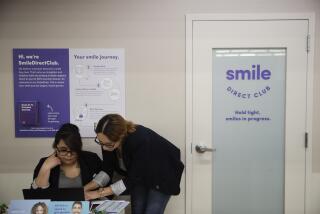Dentist Gives Up Private Practice to...
- Share via
CENTER, Colo. — In Colorado’s San Luis Valley, an area roughly the size of Massachusetts, migrant workers and other poor people have only one person to turn to when they get a toothache.
He’s Dr. Charles Belting, the staff dentist at Valley-Wide Health Services in this village on the north end of the valley, the only rural public health clinic in the state.
To reach another public health clinic, Belting’s patients would have to travel 150 miles to the east to Pueblo, about 200 miles to the west to the Montrose-Delta area or about 100 miles to the south to Questa, N.M.
“North? Well, there just aren’t any,” Belting said. “They’re all private up that way.”
There are only about a dozen other dentists--all in private practice--in the entire San Luis Valley, which covers 8,200 square miles and encompasses some of the poorest counties in the state.
“There isn’t enough of me,” Belting said.
*
Belting typically works 10 to 11 hours a day. When he’s not working in the clinic, he may be visiting migrant labor camps or lecturing students on good dental practices.
More than 90% of his patients are at or below the poverty level and the rest, he said, are “patients who can pay a portion, or all, of the fee.
“It would take at least three more dentists and a full-time hygienist to do the job adequately,” he explained.
A Chicago native who earned his DDS degree at Northwestern, Belting, 39, turned his back on private practice and its financial rewards seven years ago to move to the valley.
“I’d driven through here and was aware of the poverty,” he said. “I wanted to help out and do something about it.”
He was in private practice in Arizona before taking the Valley-Wide job.
“I liked the money,” he conceded. “I believe I have the skills to be a really good dentist, but I want to share. It’s a giving-back concept, a spiritual path. It involves God.”
Belting’s clinic runs on Medicaid funds and has a sliding scale for patients.
Typically, a visit to the dentist costs $5 to $10, but some patients “can’t even pay their light bills,” he said.
“If they don’t pay, we don’t make a big deal out of it.
*
“You find a lot of people, like the migrant workers, who feel an obligation to pay even as little as a dollar a week to work off a $5 fee,” Belting explained. “They are so concerned about being honest, even with that small an amount.”
Belting’s practice generally is limited to pain relief, extractions and such.
He refers patients who need extensive dental work or oral surgery to clinics in Pueblo.
“Our main concern is to prevent dental problems and take care of acute pain,” he said.
*
Belting calls on dental students from the University of Colorado Dental School and the University of Texas for help, as well as retired dentists and the dozen or so private practitioners in the valley.
Belting concedes he sometimes thinks of the good life of private practice.
“If I have a bad day, I’m tempted,” he said.
“But I’m dedicated to helping people. I have enough to live on. I drive an old diesel pickup and I don’t live in a fancy home,” he added.
By his estimation, Belting earns about a third to a half what a dentist in private practice makes. However, as he put it: “I don’t need $40,000 or $50,000 to make me happy.”
As a public health dentist, Belting’s salary is paid by the clinic, which gets its money from federal community health center grants.
Belting recently received a $100,000 grant from the Robert Wood Johnson Community Health Leadership Program, the country’s largest nonprofit group dedicated to bettering U.S. health care, to help continue his efforts.
*
Belting was nominated for the grant by his boss, Marguerite Salazar, executive director of Valley-Wide Health Services.
He was one of only 11 dentists receiving the award from among 300 nominees nationwide.
Of the grant, $5,000 was intended for his personal use.
He split it among his staff--hygienist Ted Johnson and assistants Tony Velasquez and Rose Espinosa--and “recycl(ed) it back into the clinic.”
The rest of the money will go toward establishing another clinic in Alamosa, about 35 miles away, a more central location for a clinic in the valley.
It also would entail hiring another dentist.
“Some of our patients have to travel from 30 to 90 miles one way to get here,” Belting said.
“It’s very inconvenient and most of them don’t have very much money.”
*
Belting would maintain the clinic in Center because the location “serves the migrant camps, some of whom have never seen a dentist for 10 years.”
“For some of them, I’m the first dentist they’ve ever seen,” he said.
There’s never enough money.
“If the government wanted to solve uninsured health care, they should put more money into this system,” Belting said.
“Hopefully, community health centers will get some recognition in health care reform.”
More to Read
Sign up for Essential California
The most important California stories and recommendations in your inbox every morning.
You may occasionally receive promotional content from the Los Angeles Times.













